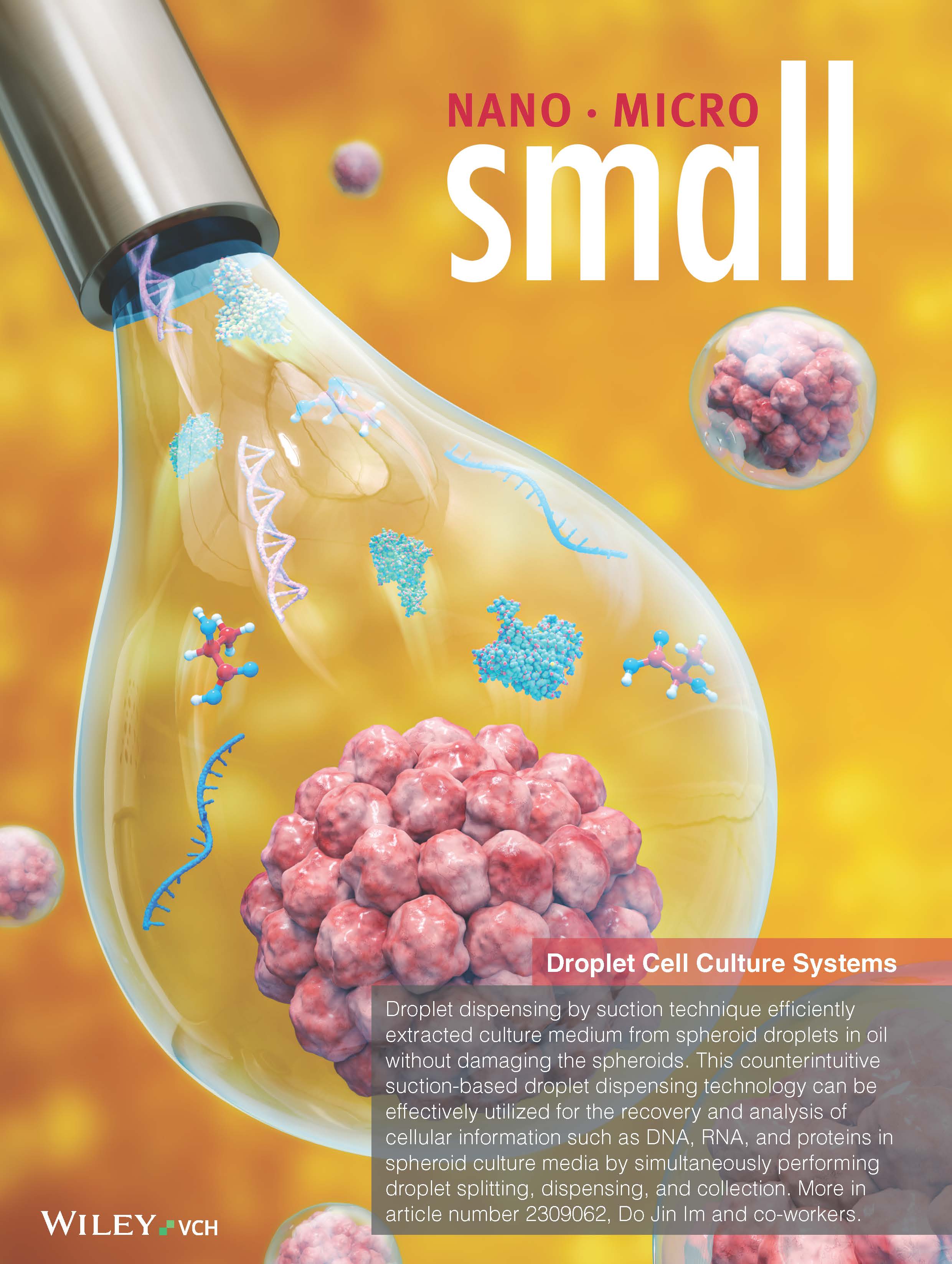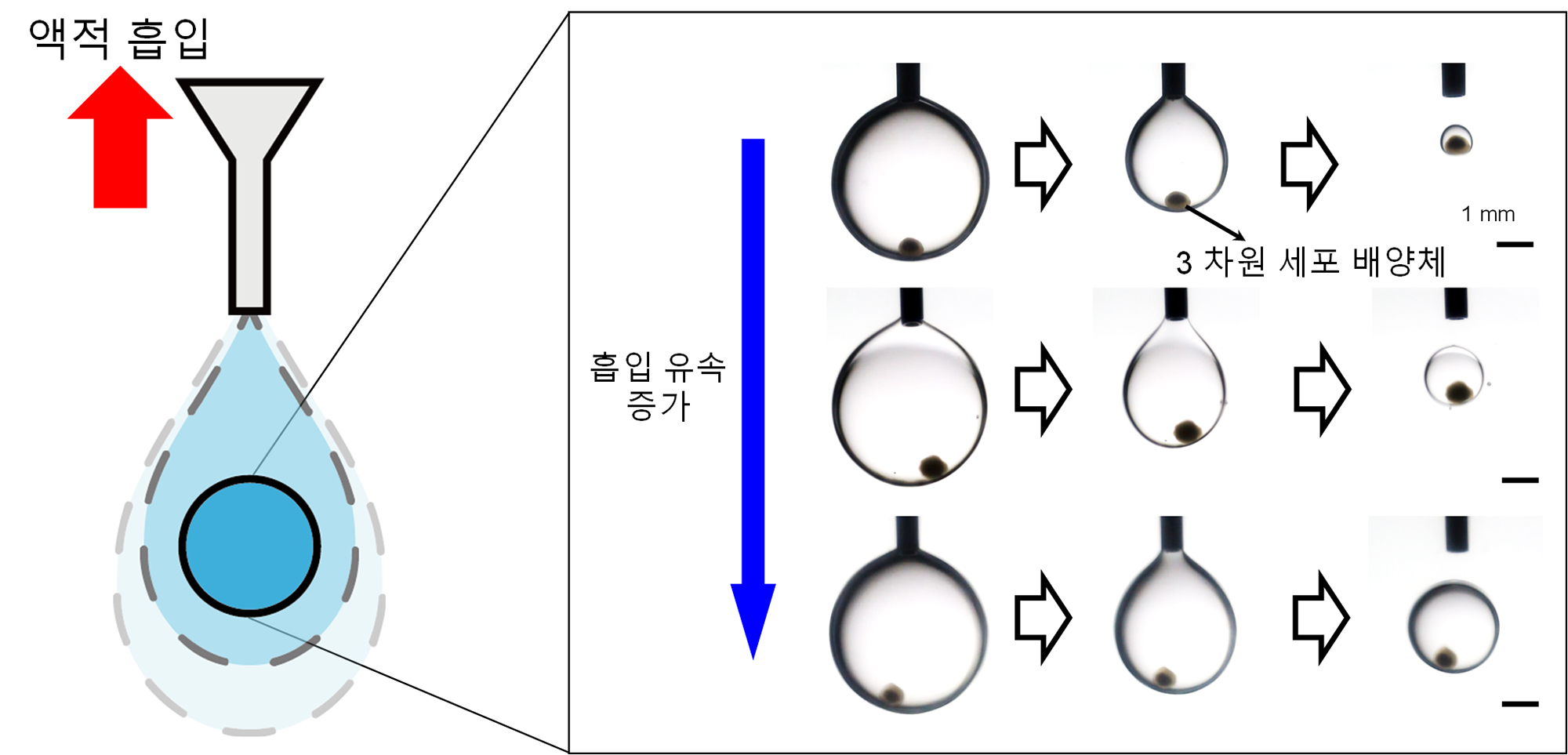커뮤니티
부경투데이
- 국립 부경대학교의 다양한 모습과 소식을 접하시면 부경대학교가 한번 더 가까워집니다.
| <small> 표지논문 실렸다(Featured as the cover paper of <Small>) | |||
| 작성자 | 대외협력과 | 작성일 | 2024-05-07 |
| 조회수 | 447 | ||
| <small> 표지논문 실렸다(Featured as the cover paper of <Small>) | |||||
 |
대외협력과 |  |
2024-05-07 |  |
447 |
국립부경대 임도진 교수 연구팀, 국제학술지 표지논문 게재
- 국제학술지 <Small> … 흡입 이용한 혁신적 액적 디스펜싱 기술 개발

국립부경대학교 임도진 교수(화학공학과) 연구팀의 논문이 국제학술지 <Small>(IF 13.3) 표지 논문으로 실렸다.
<Small>은 존 와일리 앤 선즈(Wiley)가 발간하는 나노기술 분야 저명 국제학술지다.
여기에 표지로 실린 논문 제목은 ‘Simultaneous Separating, Splitting, Collecting, and Dispensing by Droplet Pinch-Off for Droplet Cell Culture’이다.
임도진 교수 연구팀은 이 논문에서 차세대 인공 장기 모델인 오가노이드(organoid)의 배양 자동화를 위한 신개념 액적 디스펜싱 기술을 개발해 제시했다.
오가노이드는 줄기세포를 이용해 인공적으로 만든 장기 모델로, 실제 장기를 매우 유사하게 모사할 수 있어 신약 개발 기초 연구에서 주목받고 있다.
하지만 줄기세포의 분화를 유도해 오가노이드를 형성하고 유지하기 위한 모든 과정이 매우 번거롭다는 단점이 있다. 특히 대부분의 배양액을 효율적으로 교체하기가 매우 어렵고, 이 과정에서 세포 손상의 위험도 있다.
연구팀은 이 같은 문제를 해결하기 위해 흡입을 이용하는 신개념의 액적(아주 작고 둥근 물방울) 디스펜싱 기술을 이용했다. 그 결과 3차원 세포 배양체 액적에서 99% 이상의 배양액을 세포 손상 없이 효율적으로 교체 및 회수하는 성과를 얻었다.
이번 연구 논문의 제1 저자인 배서준 박사과정생은 2,000개 이상의 실험 영상을 체계적으로 분석해 액적을 흡입하는 유속이 디스펜싱되는 액적 크기에 큰 영향을 미친다는 것을 발견했다.
그는 “액적 디스펜싱 기술이 액적의 분배와 분할, 회수를 동시에 가능하다는 점에서 오가노이드 배양 자동화 플랫폼의 개발에 유용하게 활용될 수 있을 것으로 기대한다.”라고 밝혔다.
임도진 교수 연구팀은 한국연구재단의 중견연구자 지원사업의 지원을 받아 이번 연구를 수행했다. <부경투데이>

△ 흡입을 이용한 액적 디스펜싱 과정의 모식도와 액적을 흡입하는 유속에 따른 디스펜싱된 액적의 크기 변화 결과 이미지.
Prof. Im Do-Jin's research team at PKNU published as the cover paper of an international academic journal
- published in the international academic journal <Small>... research on the development of innovative droplet dispensing by suction technique
The paper by the research team of professor Im Do-Jin (department of chemical engineering) at Pukyong National University was published as the cover paper of the international academic journal <Small> (IF 13.3).
<Small> is a renowned international academic journal in the field of nanotechnology published by John Wiley & Sons (Wiley).
The title of their paper featured on the cover is 'Simultaneous separating, splitting, collecting, and dispensing by droplet pinch-off for droplet cell culture'.
Professor Im Do-Jin's research team developed a novel droplet dispensing technology for the automated cultivation of organoids, which are next-generation artificial organ models, and presented this technology in the paper.
Organoids are artificially created organ models using stem cells, and are gaining attention in basic research for new drug development because they can closely mimic real organs.
However, there is a significant drawback in that the entire process of inducing stem cell differentiation to form and maintain organoids is extremely cumbersome. It is very challenging to efficiently replace most of the culture medium, and there is a risk of cell damage during this process.
To solve this problem, the research team used a new concept of liquid droplet (very small, round water droplet) dispensing technology that uses suction. As a result, more than 99% of the culture medium in the 3D cell culture droplet was efficiently replaced and recovered without damaging the cells.
Bae Seo-Jun, a phd. candidate and the first author of the paper, systematically analyzed over 2,000 experimental videos and discovered that the flow rate of suctioning droplets significantly affects the size of the dispensed droplets.
He mentioned, "I expect that the droplet dispensing technology, which enables the simultaneous distribution, splitting, and recovery of droplets, will be useful in developing automated platforms for organoid cultivation."
Professor Im Do-Jin's research team conducted this research with the support of the mid-career researcher Program from the National research foundation of Korea. <Pukyong Today>